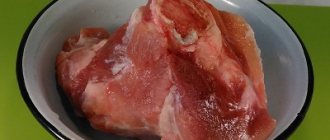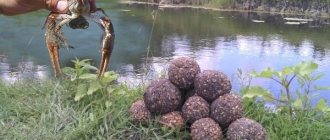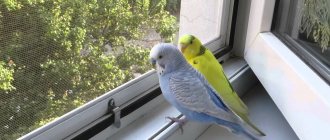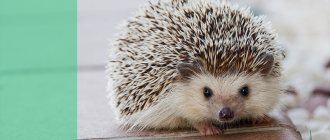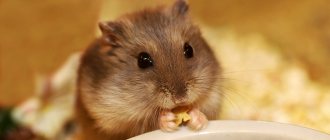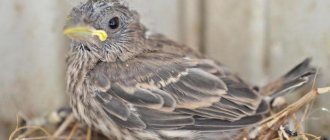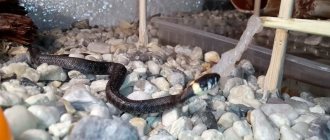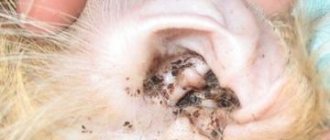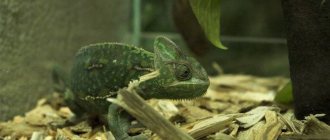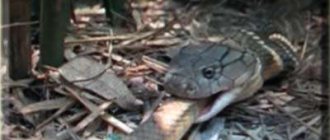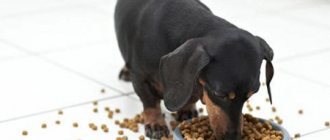Crayfish are very unpretentious eaters and absorb food of both plant and animal origin with equal ease. Largely due to this lack of pickiness, people have a desire to start breeding arthropods at home. However, in order for the idea to be crowned with success, it is necessary not only to know what to feed the crayfish, but also to understand all the intricacies of caring for them.
Successfully breeding crayfish at home requires certain knowledge.
What do crayfish eat at home?
Crayfish are omnivores. Their diet contains both animal and plant foods. At home, stick to this menu when choosing food for crayfish.
Arthropods have a well-developed sense of smell. In nature, they quickly find dead fish by smell. At home, replace such prey with bloodworms, pieces of fish, meat, squid or shrimp.
Crayfish are given animal food no more than twice a week. There is a widespread belief that it increases the aggressiveness of arthropods.
Crayfish in their natural environment feed mostly on algae, but also come out onto land and feast on grass and leaves. To keep your pets in good shape, plant hornwort or elodea in the aquarium. Plants contain lime, which is necessary to maintain the strength of the shell or grow a new one after molting.
The following are also suitable as plant food:
- lettuce leaf;
- carrots, zucchini;
- spinach;
- nettle.
Regular feeding
In nature, the diet of crayfish consists of 90% plant foods. The remaining 10 are phytoplankton, invertebrates and small fish. Cancer eats dead fish and animal meat.
For convenience and to reduce the cost of time and money for maintenance, create natural living conditions:
- Apply organic and mineral fertilizers without exceeding the norm: nitrogen 0.5 mg/l, phosphorus 2 mg/l. Crayfish are susceptible to the composition of water and dirt will cause the animals to escape or even die. Apply fertilizers before filling the reservoir. Industrialists have a recommended proportion of 1 kg of superphosphate and 50 kg of ammonium nitrate per 1 ha.
- Fertilizers can be replaced with legumes. Their use is environmentally friendly and saturates the water with nitrogen.
- The acidity in the reservoir should not exceed 7–8.5 pH.
- To provide the elements necessary for the growth of a new shell, plant plants rich in lime.
- Introduce daphnia, cyclops, snails, tadpoles and small fish into the pond. By catching them, crayfish will be able to partially provide themselves with food. Phyto and zooplankton will serve as food for both the crayfish themselves and their prey.
Types of crayfish for breeding
Arthropods can be grown in ponds or special aquariums. The variety most suitable for breeding is selected based on the intended maintenance method:
- Crayfish, which hibernate when the temperature drops significantly, will feel much better in a pond where conditions are as close as possible to their natural habitat. This method of cultivation is also considered less expensive: since any body of water eventually becomes a formed stable ecosystem, arthropods will be able to feed on what the pond gives them, allowing the owner to save on food. Among other things, crayfish are cheaper than their other relatives (and if you wish, you can catch them for free in reservoirs).
- Large blue or lake species are not prone to suspended animation and adapt well to artificial conditions, so they can be grown even in an average apartment. But you need to take into account that these varieties grow quickly, reaching impressive sizes, and are thermophilic.
Read more: content of blue cancer.
To create a farm, it is better to buy sexually mature individuals with a length of at least 8 cm. For each male there should be two females - the latter are distinguished by an undeveloped upper pair of limbs and a wider abdomen.
Types of feed
Crayfish are omnivorous, with the exception of products with synthetic and chemical additives. Feed can be either industrial or self-prepared.
Self-cooking
When creating your own diet, remember to balance animal and plant foods. Homemade food for crayfish includes:
- pieces of raw meat, chicken, fish;
- earthworms, maggots, bloodworms;
- a variety of vegetables;
- nettle;
- bread;
- seaweed.
Do not give crayfish fatty foods, which will pollute the water.
Industrial manufacturing
Release form: flakes, granules of different sizes or sticks. Regardless of appearance, the food chosen should be:
- balanced;
- do not pollute water;
- contain elements that facilitate molting.
Some types of feed are formulated specifically for different stages of cancer's life. There are varieties of complementary foods to stimulate reproduction, enhance the color of the shell, and strengthen the immunity of the fry.
Feeders
You should not throw food for the inhabitants of an aquarium or pond directly into the water. It's better to buy a feeder. The store offers a wide range of products that differ in size and shape. The main factor determining the choice is the absence of toxic substances in the composition of the material.
The design of the feeder consists of a fixed platform on which the feed is placed, and fences. It can be made accessible to everyone using available means and materials. A sheet of wood or non-toxic plastic is taken as a basis, and the sides are fixed at the edges. That's it, the feeder is ready!
Rules and features of feeding
- Crayfish are thrifty creatures and know how to hide food. Excess food will cause the water to dry out and the pets will die.
- Control your diet so that you have enough food, but not excess.
- During molting, more food is required, this is due to the energy costs of restoring the shell.
- The breeding season also requires an increase in portions.
- The diet of juveniles differs in composition and volume from the diet of adults.
- Males can feed once every 2 days, and females once every 3 days.
- Leave the shell in the aquarium after molting. It is part of the diet of wild arthropods. By eating the shell, they restore the normal level of calcium in the body.
- Crayfish are nocturnal animals. Feed them in the evening.
- Make sure there is enough food, otherwise the crayfish may start eating each other.
- But also a lack of food will lead to attempts by arthropods to escape.
Artificial feeding and groundbait
If you do not have the opportunity to create favorable conditions for crayfish at home, then you should pay attention to the artificial food that your pets eat.
First of all, keep track of where they gather most often, and try to throw food in this area. It is also worth remembering that crayfish are nocturnal animals, and therefore it is better to feed them in the evening.
It is best to feed the fingerlings:
- Minced meat (fish, meat);
- Boiled vegetables;
- Compound feed for herbivorous fish.
It is important to exclude various fatty foods, which can ruin water, leading to death. For a faster growth rate of fingerlings at home, various supplements can be added to the food.
The best artificial nutrition for adult crayfish is:
- Spoiled meat;
- Rotten fish;
- Vegetable trimmings;
- Soaked cereals;
- Pieces of bread.
In addition, they may be suitable for food:
- Worms;
- Young frogs;
- Bloodworm.
From the diet you can understand that crayfish really like various carrions, however, it is worth remembering that this kind of food pollutes the aquarium. To avoid rapid spoilage of water, it is advisable to use dried meat as food at home as little as possible. And this dish should be served in a special feeder, which you can make at home yourself.
Take an old board, preferably 10-15 cm wide, saw off a piece of about 20 cm and nail the sides along its edges, no higher than 2 centimeters. The feeder is ready, nothing complicated.
It is difficult to say about the amount of food required for one individual crayfish, however, it is worth considering that you cannot feed these animals if there is food in the feeder. Water transparency will help determine this:
- If you see a feeder and it is empty, then feel free to give the crayfish a new portion of food.
- If the water is cloudy, then you should pull out the feeder and check whether feeding is necessary.
In both cases, you should remember a simple rule - it is better to underfeed than to leave extra pieces of food in the aquarium. Old food in the process of decomposition will clog the water, after which pathogenic bacteria can develop in it, which will lead to a pestilence of crayfish.
Norm in the diet
- The female eats more than the male, but also takes longer to digest food.
- There is no clear standard for the amount of feed. Fresh food is added to the feeder only when it is empty.
- The remaining food is removed after two days, otherwise the decomposition process will begin, polluting the water in the aquarium.
- 2–3% of the animal’s weight is the recommended amount of food. Pets will be full and there will be no surplus left.
- It is better to slightly underfeed the crayfish than to allow them to die due to spoiled water.
Reproduction
The mating period begins after the molt . Females secrete pheromones that excite and attract males. The mating process itself lasts several hours.
After 20 days, the female lays eggs, which she then carries on herself. To ensure the necessary comfort, it is better to move her to a single aquarium. Until the first molt, young crustaceans will stick to their mother. After the second molt, it is better to remove the female from her offspring. Provide the aquarium with a very large number of shelters for crustaceans. During the molting period, even sisters and brothers can attack each other. The more shelters, the more individuals can survive.
Feeding the young
The growing body of young crayfish requires a larger volume of varied food.
Before reaching a length of 2 cm, they require detritus - a product of the breakdown of organic matter. In nature, at the bottom of a reservoir, it is quite enough for young individuals. Due to constant filtration, there is not enough detritus in the aquarium.
Dry leaves of oak, alder or beech are used as feed. Not only young crayfish eat them, but also adults. Add leaves as you eat them. Do not use fresh leaves. They are capable of releasing a dangerous toxin into the water. Two-centimeter crustaceans begin to eat various insect larvae. From three centimeters of height, shellfish are included in the diet. Having reached 4 cm, the crustaceans begin to eat small fish.
You can feed young fish at home using food intended for fish fry. Aquarists advise adding small daphnia to the diet. Before being introduced into the aquarium, daphnia is scalded with boiling water to reduce mobility.
If you decide to start breeding
To get started, remember a few things:
- You will not be able to raise many individuals at once.
- It’s worth purchasing several aquariums right away. Cancers need to live separately. Why? Because older individuals can eat young ones.
- Mature individuals should be placed in a separate pond, leaving small ones in a more familiar environment. This way you will protect the young animals from unnecessary stress.
- Also respect the population density. There should be no more than 5 individuals per 1 square meter.
Interesting: The main features of amphibians, and how a frog differs from a toad
Adviсe
- In summer, the amount of food needed increases.
- In winter, when kept outdoors, there is no need to feed crayfish until spring.
- Their growth and reproduction rate depend on what they feed crayfish.
- Crayfish do not like turbidity in a pond.
- A properly prepared living area will reduce feed costs.
- For the growth of juveniles and reproduction, a comfortable temperature of about 15 degrees.
- Crayfish are inhabitants of clean bodies of water; their behavior makes it immediately obvious if something is wrong with the water.
How to feed crayfish when catching them?
Bait for catching crayfish is selected based on the season of the year. Vegetable complementary foods are effective in spring and summer. In autumn and early winter, animal food is used to feed arthropods. For this use:
- meat trimmings;
- fish;
- entrails of fish and poultry;
- shellfish;
- worms;
- snails;
- frogs;
- meat.
The fish is served fresh or slightly spoiled. To enhance the smell, it is dried a little in the sun. Cancers like roach, crucian carp and bream. For meat products, it is advisable to use poultry or meat carcass. It is also served stale. Clams, snails and frogs are caught in the same body of water where they are going to catch crayfish. Worms are used extremely rarely in the absence of other options: they are placed in a piece of thin gauze, preventing them from spreading.
Of the vegetable baits, it is most effective to use corn, dill, peas, black bread, macadamia, and garlic. Peas and corn are boiled, steamed or purchased canned. Crustaceans are attracted to the garlic aroma, which is why it is recommended to add it to other products.
When choosing bait, take into account the time of year:
| Season | What to feed? |
| Summer | They are fed with a piece of liver, meat, and chicken giblets. To enhance the smell, fish oil is added. |
| Spring | They use vegetable bait or fish, which are first cut along the ridge, turned inside out and left in the sun to spoil. |
| Winter and autumn | It is recommended to use rancid meat or peas. |
The habitat is also very important. For hunting in reservoirs with muddy bottoms, it is advisable to use bait made from spoiled fish. It is a common food for crayfish that live in such conditions. Arthropods will crawl into the “trap” without suspecting anything. If there is a lot of vegetation at the bottom, using peas or corn is more effective.
For fishing in underwater caves or under the shore, bait with a strong smell of garlic or spoiled meat is used. In shallow water, experts advise using worms, shellfish, and corn for bait.
The most common cancer diseases
Like any other animals, these arthropods are susceptible to various ailments. Health problems can be caused by overfeeding, insufficient aeration, dirty water, untested food, temperature imbalance or infection.
The most common illnesses that crayfish can contract include plague and porcelain disease. All of them have a bad effect on the appearance of arthropods and their ability to reproduce. In some particularly severe cases, the infection can lead to the death of an entire generation of crayfish. Therefore, at the slightest suspicion of animal health problems, you need to show it to a veterinarian.
Care and maintenance - general principles
The main rule for keeping crayfish in an aquarium is the presence of clean, high-quality water, the condition of which is constantly maintained by a filter. An aerator and a heater are also essential assistants in caring for your arthropod pet.
| Volume of water (liters per 1 individual) | Temperature (°C) | Acidity (pH) | Hardness (dGH) |
| 70 | 20 – 26 | 5 – 8 | 8 – 12 |
One of the most important parameters of water for crayfish is its hardness, because in too soft water the animal’s shell slowly collapses, which will inevitably lead to its death.
The soil in the crayfish house should be medium with a fraction size of 5 to 1.5 mm because arthropods arrange their own homes and love to dig holes. For the same reason, the aquarium must contain well-rooted aquatic plants, near which the crustacean can build a shelter for itself, and thanks to the root system of the plants, the hole will not collapse.
It is definitely worth equipping the aqua with decorative grottoes, which will also serve as a shelter for the secretive pet.
Crayfish are prone to escape, so the aquarium must be covered with a lid or glass. You won't believe how deftly these little guys can climb equipment and glass to escape the aquarium. Most often, escapes are arranged by pregnant females, in search of a place to give birth.
Other interesting articles
- What to feed angelfish in an aquarium at home Due to an incorrectly selected diet, even such unassuming fish as angelfish can get sick and lose their...
- How to feed snails at home in an aquarium Many aquarium owners get snails without knowing at all whether they are compatible with other inhabitants of the aquarium...
- What to feed crucian carp at home in an aquarium Crucian carp, perch, roach and ruffe are fish designed to exist in natural bodies of water. However, with…
